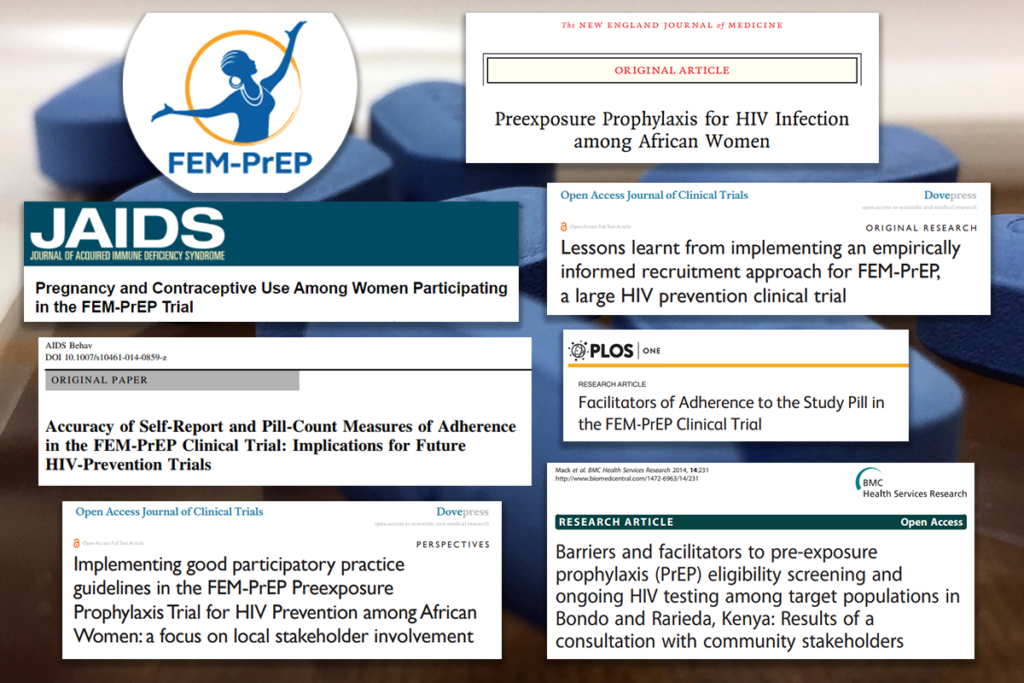With scientists, funders and policymakers becoming increasingly concerned about the stability of government investment in health research, scientists must identify ways to maximize scientific progress in the presence of potential narrowed funding. Here, I will describe a structured approach to ensure research investments produce maximal results through harnessing the information already available in rich clinical trial data sets.
Here, I will describe a structured approach to ensure research investments produce maximal results through harnessing the information already available in rich clinical trial data sets.
The FEM-PrEP clinical trial, implemented by a global team of scientists from Belgium, Kenya, South Africa, Tanzania and the United States, evaluated the effectiveness of daily oral Truvada for HIV prevention among 2,120 women at high-risk of HIV in eastern and southern Africa. While the trial was unable to demonstrate efficacy of Truvada for HIV prevention, the rich prospective data collected during the study yielded important behavioral and social science, clinical, laboratory and operational findings well beyond the primary null result. (Check out this blog post that outlines three steps for designing studies so that null results are meaningful.)
The multi-disciplinary trial team used a structured approach to identify secondary research questions and conduct analyses, yielding novel findings presented in more than 30 peer-reviewed manuscripts in the five years following trial closure. The structured approach, which I will describe here, provided ongoing motivation and resources to researchers following trial closure, contributing to maximal scientific progress from a single trial.
Identify a publication champion
Identify a publication champion.
First and foremost, identification of a publication coordinator and champion is essential to support new authors and sustain author motivation, over a sometimes grueling and lengthy writing-to-publication timeline. The publication champion must have covered time to invest with numerous writing teams and be tasked by institutional leadership with diligent follow-up of those teams through the publication process. As new projects arise, researchers are under pressure to direct their attention toward those new projects, with little time to focus on data analysis from past projects. Through routine communication, the publication champion can motivate ongoing efforts and assist in the resolution of challenges during the secondary analysis and publication process.
Conduct a writing workshop
Conduct a writing workshop.
A writing workshop, which can be done remotely or face-to-face, is useful for generating secondary research ideas, engaging junior staff with limited prior publication experience, identifying writing teams and again, motivating ongoing secondary research. The writing workshop environment stimulates critical thinking through discussion between research teams of diverse educational and training backgrounds, provides training for team members with less writing and publication experience, and provides the opportunity for junior researchers to partner with experienced researchers – a key element to assuring secondary design and analytic approaches are sound.
Centralize statistical support
Centralize statistical support.
Subsequent to the writing workshop, provision of centralized statistical support from the sponsoring institution ensures accuracy of secondary analyses and provides both junior and experienced authors technical support during the analysis and publication process. Clinical researchers often lack extensive statistical training, and may be inhibited to pursue secondary research questions as a result. The availability of expert statisticians provides researchers confidence to overcome this potential barrier to analysis and publication.
Identify a centralized manuscript editor
Identify a centralized manuscript editor.
Lastly, identification of an experienced writer who can serve as centralized manuscript editor can improve the quality of initial submissions, increase the probability of publication and allow scientific staff, with often limited time, to focus on the technical aspects of the publication. This is a particularly motivating component of the structured process for researchers for whom English is a secondary language, and ensures that the limited time often available for researchers can be dedicated to technical input.
Using this structured approach, researchers can maximize scientific progress – even from a single trial with primary null results. As noted above, the FEM-PrEP clinical trial yielded more than 30 published manuscripts. For example, Corneli et al. identified drivers of intervention adherence and non-adherence. Callahan et al. identified an association between pre-existing health behaviors and intervention adherence, and Baetselier et al. assessed the sensitivity and specificity of two globally used HSV-2 assays, and determined HSV-2 prevalence and incidence among a population of young South African women. These manuscripts harnessed information already available and serve as an example for how to maximize research investments.
Sharing is caring!



